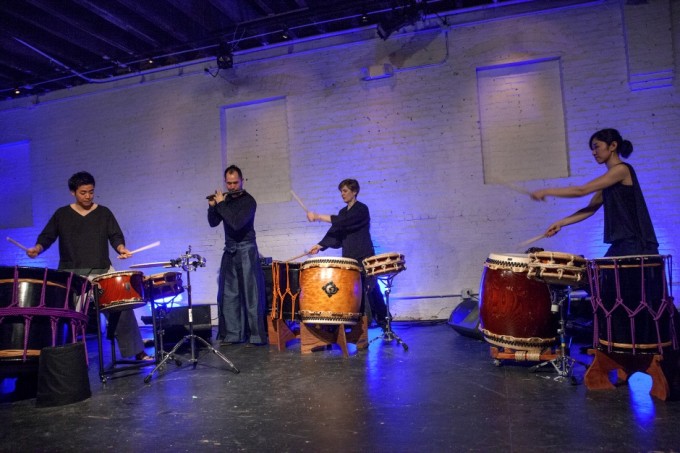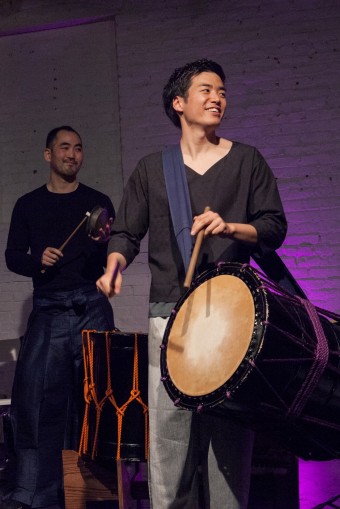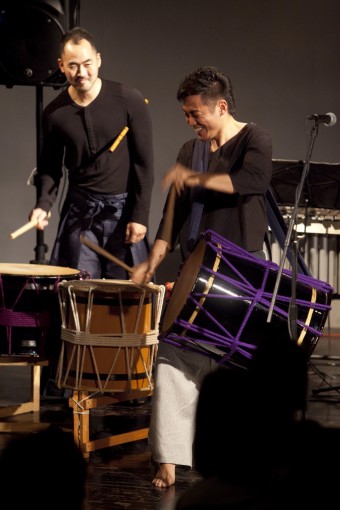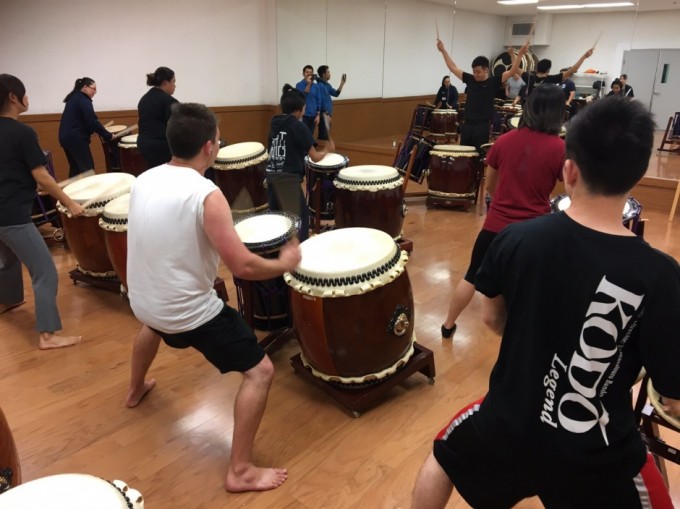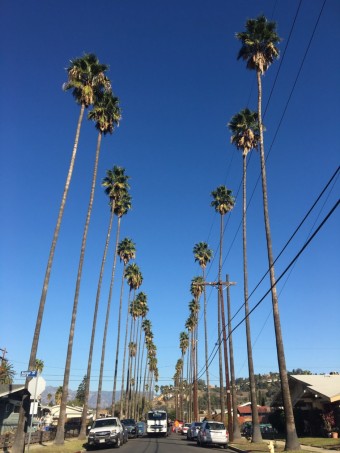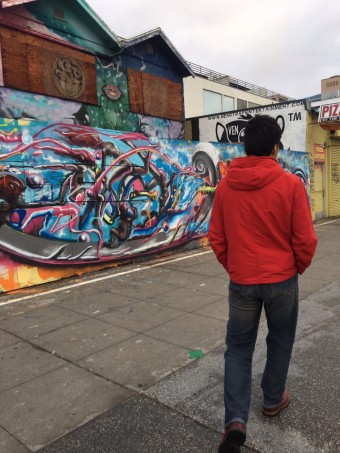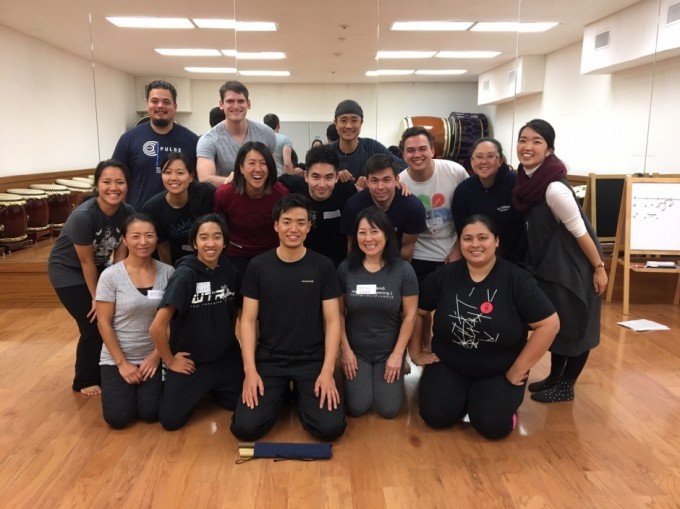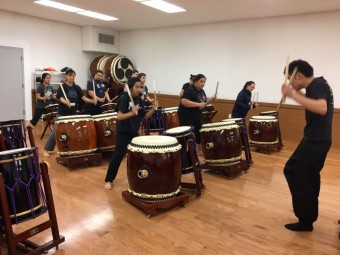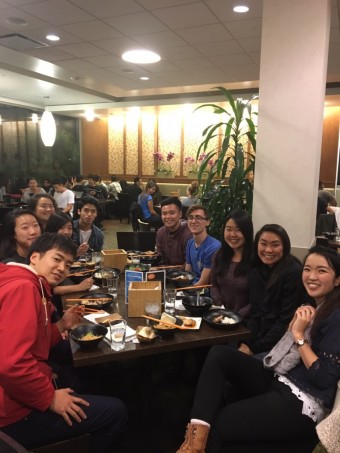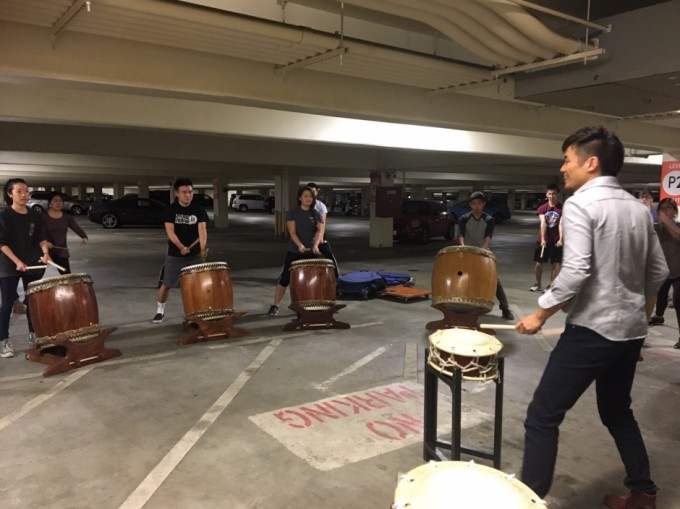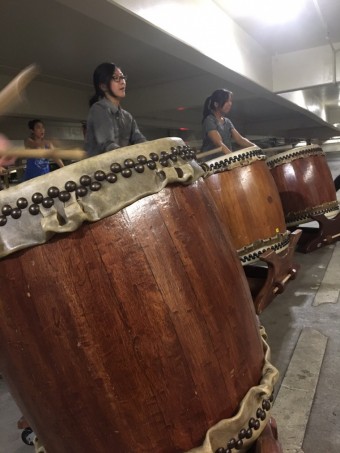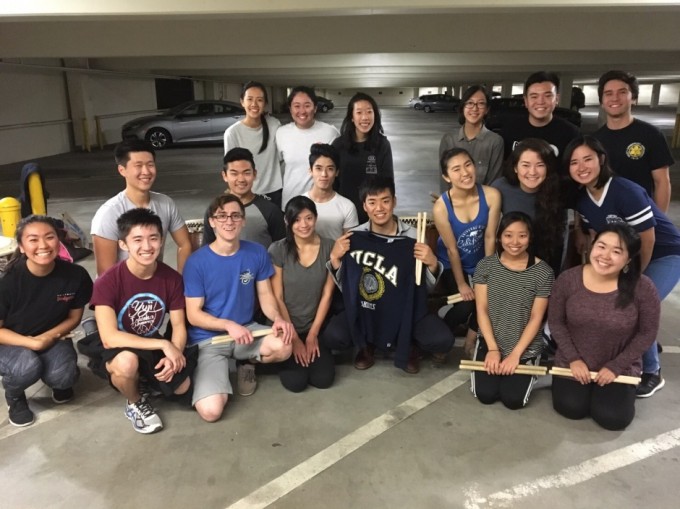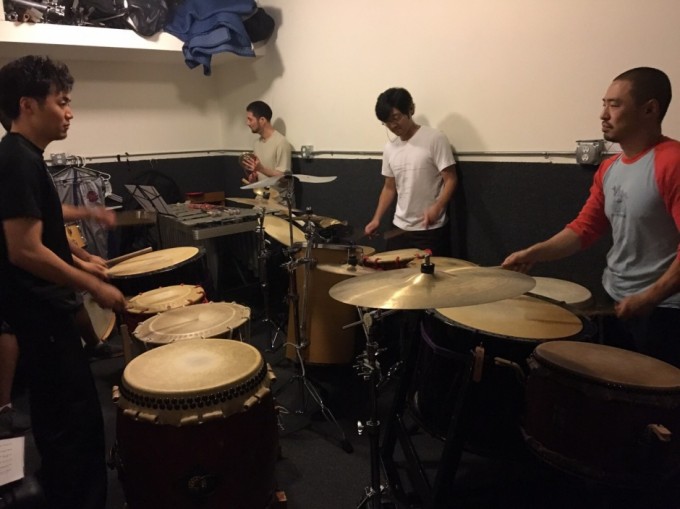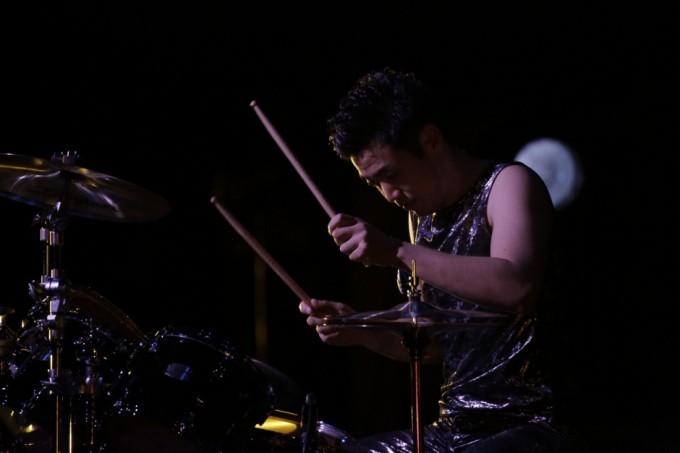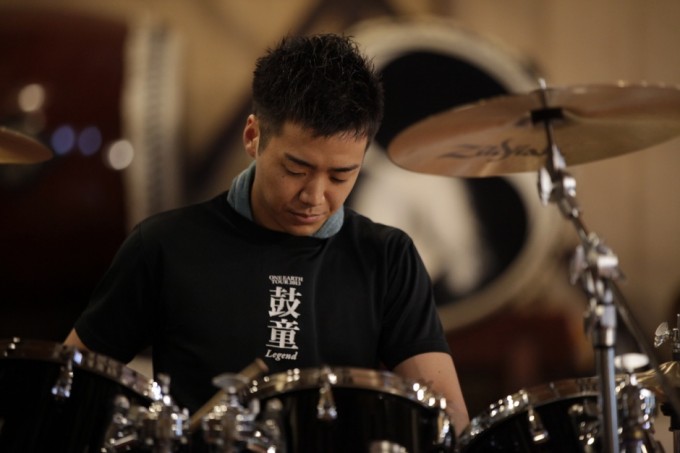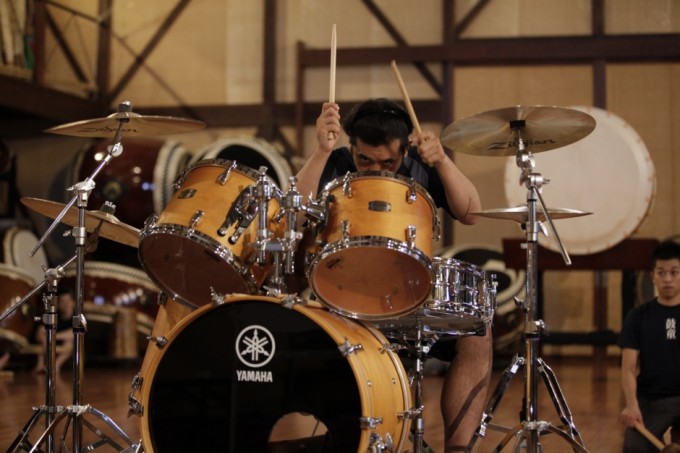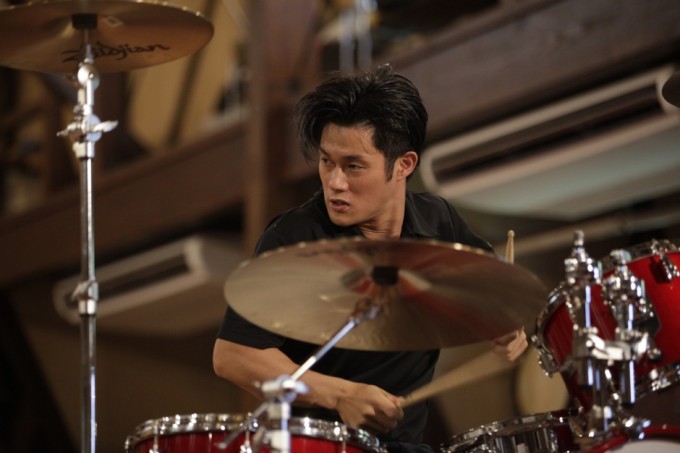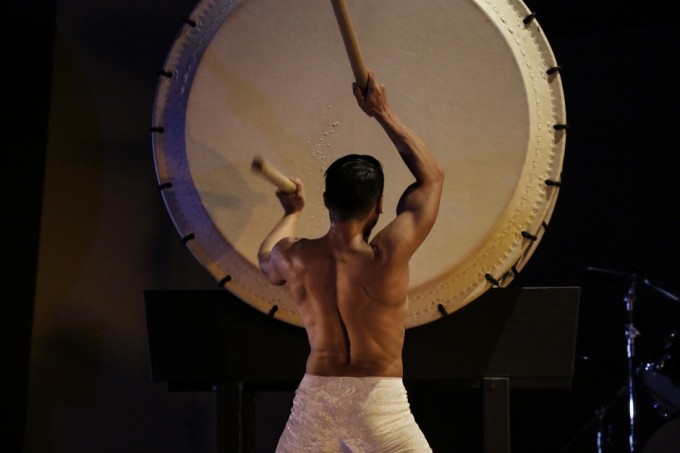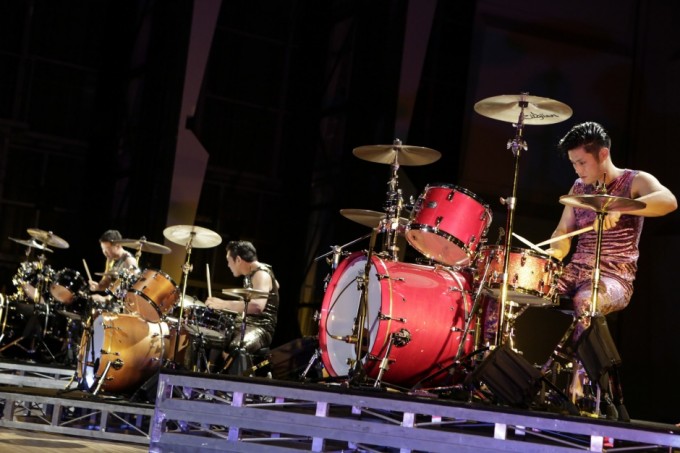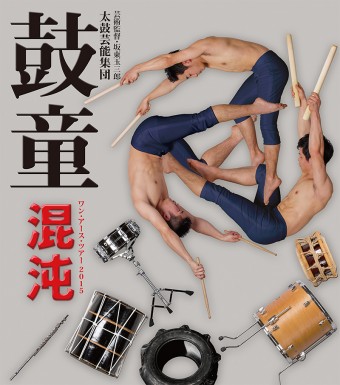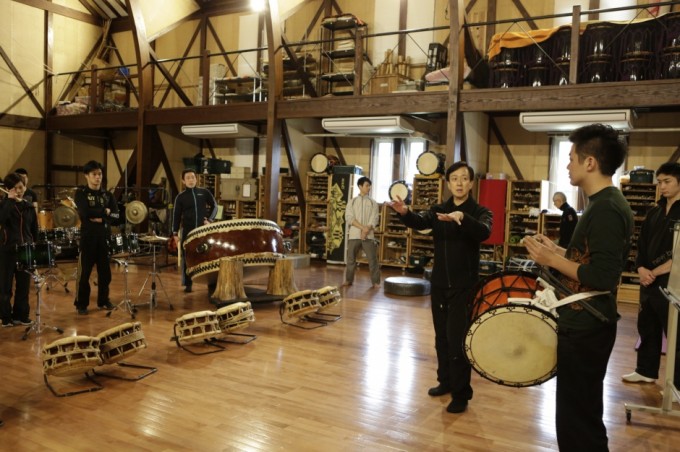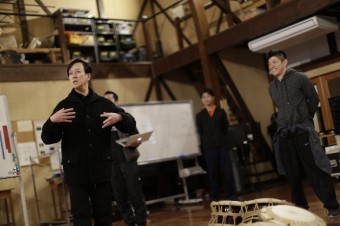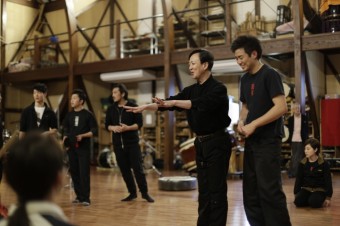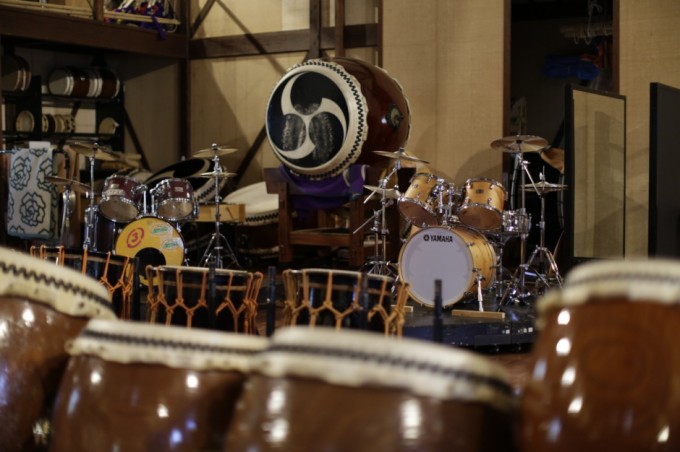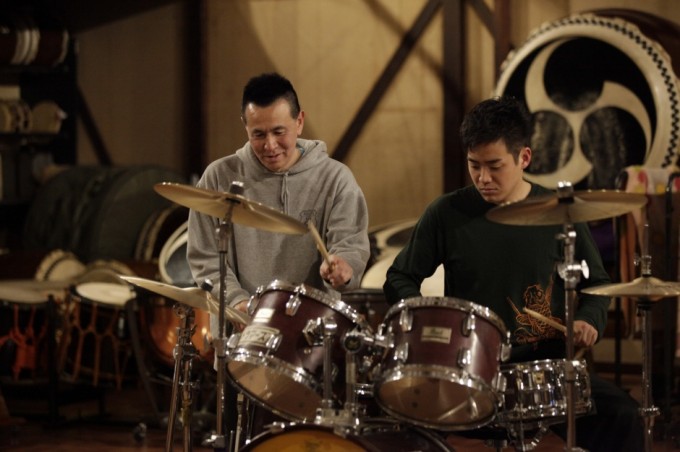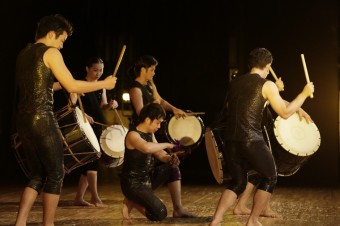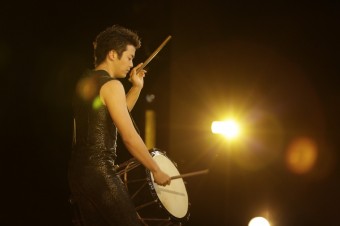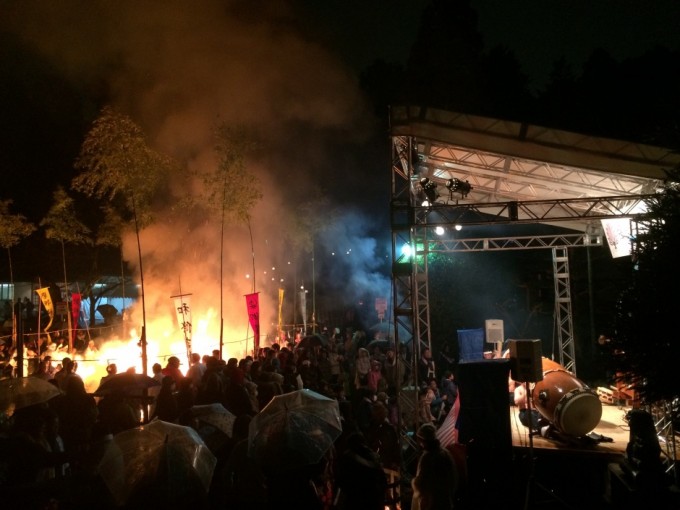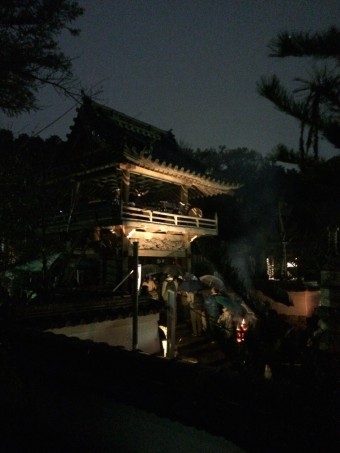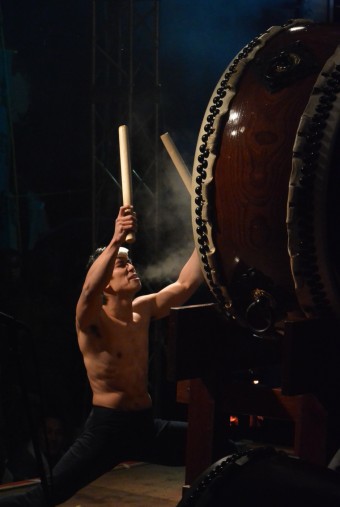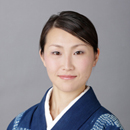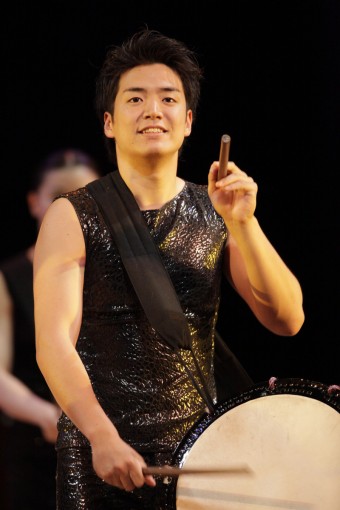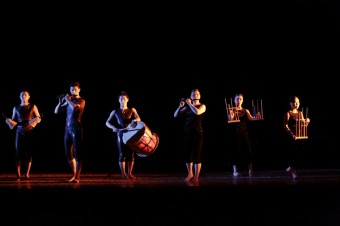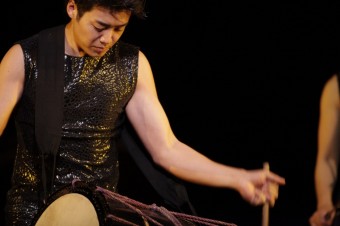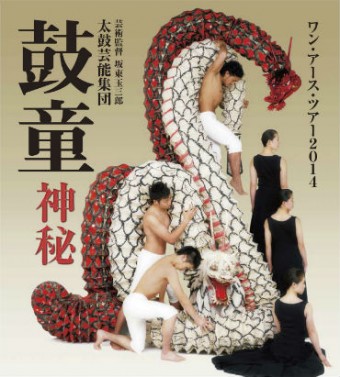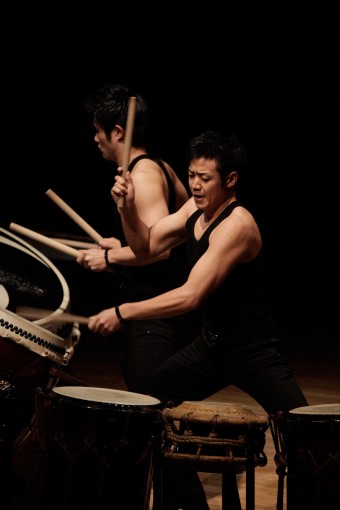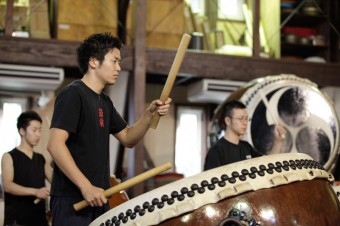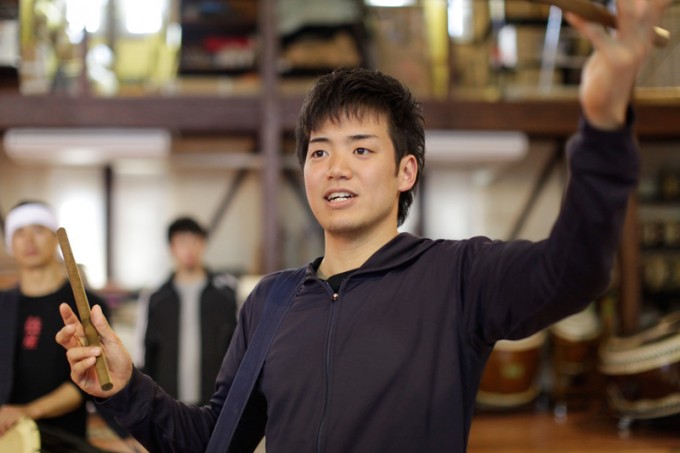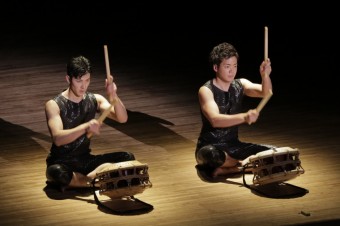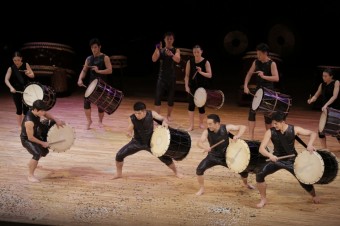Tag ‘Yuta Sumiyoshi’
“My Travels in the USA” by Yuta Sumiyoshi
My Travels in the USA
Happy New Year, everyone!
Late last year I was traveling through the USA. In case you missed it, here is a link to a blog post by Kodo staff member Yui Kawamoto who accompanied me for the first leg of my trip: [Kodo Blog] “Taiko Fun in Los Angeles!” by Yui Kawamoto
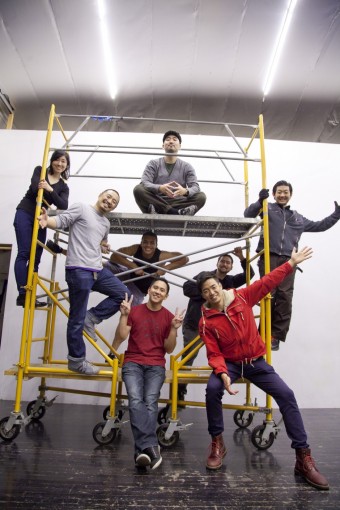
With On Ensemble, Kaoru Watanabe, Fumi Tanakadate. I’m in the front on the right.(Photo: Kim Nakashima)
Starting in Los Angeles, I traveled to San Diego, Las Vegas, Chicago, and New York, to lead workshops and take part in concerts.
Everywhere I went, I met so many different people. Taiko players and musicians, and people who are neither. Each community I encountered welcomed me and I enjoyed all kinds of exchange during my stay. Sometimes it was through sightseeing. Sometimes it was over a drink. Sometimes it was during a jam session. I was so well looked after by all the people I spent time with everywhere I went.
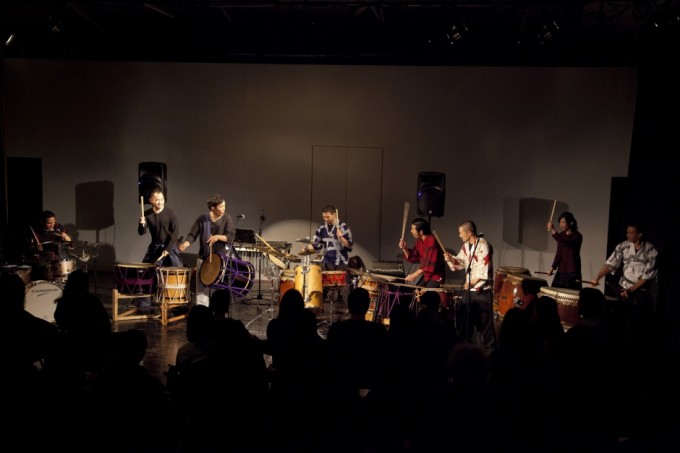
Collaboration in Los Angeles with On Ensemble, Kaoru Watanabe, & Fumi Tanakadate(Photo: Kim Nakashima)
If I start writing about what I did in each place, well, that will turn into a very long story… (lol)
So, I would like to write about some of what I felt and the lessons I learned during my travels in the US.
I planned this trip based on my own desire to see what I could do alone, as one person. Until now, I have always relied on the support of others in various ways… musically, linguistically (lol).
So I wanted to stand on my own two feet and face all those challenges myself. As I set off on this trip, I thought of it like a journey to gain and hone skills.
Instead of creating sound with a group (in my case, Kodo), on this journey all that sound would come from me. I mean that physically speaking it would be just me playing and that I would be responsible for the sound I created when I played with others. I wanted to step up to each occasion as myself, Yuta Sumiyoshi from within the Kodo group, and not as “Kodo.” I would appear alone in jam sessions, naturally, but I would carry that intent into my ensemble performances and workshops, too.
On this trip, I had many opportunities to improvise during performances. I rediscovered the sensation you get when the sound you create ignites your fellow performer, right there and then. It reminded me that when I play with Kodo that we absolutely need to feel that sensation during our performances, the sense of creating stimulus as we perform.
That sensation of spurring each other on when you perform on stage.
Noticing how good it feels, and how intense it feels until you reach that point.
Wondering how to get there. Wondering what kind of flow you want to create.
And it’s not just me playing, so I consider what kind of sounds can I create amongst different musicians. What sound do I want to create?
It’s like having a conversation with sound instead of words. (My communication in English is also like that at times, lol)
Next… I’ll play this! And I’ll add a break… here!
This back and forth becomes music and the interaction creates one big flowing dialogue.
These new sensations were really eye-opening and taught me so, so much.
The workshops I led in each place I visited were also really invigorating experiences for me. My mindset was to convey as much as possible without relying on an interpreter! (lol)
I have written about this before (maybe not in English) but in a workshop you appear as your real self. You can’t fake anything and you can’t pretend to be something you’re not. When I stand before others in a workshop, I can convey what I am particular about when I play and what I keep in mind in general. Each workshop was full of lessons for me, in the same way I learned a lot through each performance. In workshops, questions fly about from different perspectives than I am used to with Japanese people. Some questions are sharp and to the point, others are broad. In many instances, the questions I was asked made me suddenly aware of my feelings and theories about all sorts of things!
I could keep on writing about so many things, but there is too much to say and I still haven’t figured out how to sum up what I experienced on this trip. For now, I’m going to let it sink in, bit by bit, and I am going to share more thoughts with you all once the words come to me.
I am truly grateful to everyone who I met during my travels around the USA in late 2016. I am already looking forward to seeing you all again soon!
“Taiko Fun in Los Angeles!” by Yui Kawamoto
Dec. 3, 2016
Taiko Fun in Los Angeles!
Hi, everyone! Today, I am reporting from Los Angeles, California.
I grew up in this sunny city up until I began working for Kodo, as one of the staff members who handles international projects.
I am currently back home to support the first portion of Yuta Sumiyoshi’s solo performances and workshops in the United States.
The United States have one of the largest taiko population outside of Japan, and the taiko culture that exists here is one of a kind.
Everyone who is affiliated with taiko is mostly connected through the taiko community, and we exchange new ideas and thoughts in full support of one another.
Today, I would like to talk about some of the American taiko culture that Yuta Sumiyoshi was able to experience during our time in Los Angeles.
The first thing we did after flying in was an intensive workshop at the Los Angeles Taiko Institute inside Asano Taiko USA.
Despite the fact that it was Thanksgiving weekend, we had a full house for Yuta’s 5-hour workshop!
We had a wide range of age and experience levels, and everyone had a fun, challenging time!
This was Yuta’s first time conducting a workshop in the U.S., and he was able to utilize his English skills that he’s been working on.
For this workshop, he taught on multi-drum set.
In America, shime taiko and okedo taiko are commonly used for a taiko set, but for this workshop, we used two drums with a closer tone to sing the rhythmic phrases, which may have led to some new discoveries for the participants.
And I also want to tell you all about collegiate taiko as well!
The number of collegiate taiko groups have increased throughout recent years and there are more than 15 collegiate taiko groups just in California.
The first ever collegiate group was formed in 1990 at my alma mater, UCLA, called Kyodo Taiko.
I believe that my current job at Kodo was made possible with what I gained through my collegiate taiko experience, and I was thrilled to be back to introduce one of our star performers, Yuta Sumiyoshi, for a workshop.
And of course the session was held in the parking structure of the university!
With so many active clubs on campus, it is always a challenge to find a good practice space that can accommodate the loud sound that the taiko makes.
Hearing the car alarms go off during the workshop reminded me of my college days practicing really hard all the time.
Many groups in the US plays on these taiko drums made out of wine barrels, beautifully refined for performance.
Not many collegiate taiko groups have the opportunity to learn from professionals in Japan, so I was excited to see everyone immersed in the workshop, and to hear them tell me, “That was the most fun I’ve had playing taiko in a very long time”.
Our time in Los Angeles will end with an exciting show which is already SOLD OUT!
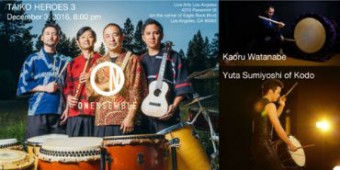
On Ensemble is one of the most respected ensembles in the world, recognized for infusing the powerful rhythms of taiko with a wide range of musical influences from jazz and rock.
Joining On Ensemble is former Kodo performer Kaoru Watanabe from New York, to present new material from his album Néo, with Fumi Tanakadate, a multifaceted musician based in New York City, and our very own Yuta Sumiyoshi.
The complexity of the musical groove created by these musicians is like no other.
Several rehearsals have taken place so far in Los Angeles, and at last, the performance is tomorrow!
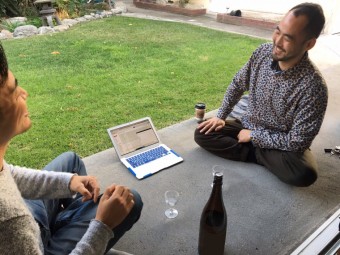
With Kaoru Watanabe
If you still want to check out what Yuta Sumiyoshi has been up to with his collaborations, he will also be in San Diego to guest appear in Kaoru Watanabe’s concert featuring his new album, Neo on December 5th!
Yuta Sumiyoshi Solo Projects in the USA (Nov.–Dec. 2016)
http://www.kodo.or.jp/news/20161127yuta_en.html
“Pounding Furiously” by Yuta Sumiyoshi
Pounding Furiously
Only three weeks remain on our current “Kodo One Earth Tour 2016: Chaos” Japan Tour. This production is a rather experimental performance and I have heard a range of feedback, both positive and negative. So, while it is towards the end of the tour, I thought I would take the time to talk about my feelings towards “Chaos” and share them with you all.
I play the drums, a Western drum kit, in this performance. Do you think I wanted to play the drums?
Well, honestly, I was really reluctant about it! (lol)
I am not sure whether reluctant is the right choice of word, but anyway, from the beginning I had this constant feeling of “We are taiko players, so why are we playing the drums?” That feeling got in my way and it stopped me from getting into our drum rehearsals properly. I was wondering if I should be playing the drums at all and I had a kind of restlessness that wouldn’t go away.
We learned to play the drums little by little, starting our practice about three years before the premiere of “Chaos.” But it took ages for me to be able to feel like, “OK! Let’s do this!” and to really put my all into it.
The biggest change in how I felt came one day during our drum practise. I think it was about six months before “Chaos” premiered. Yosuke Oda, Masayuki Sakamoto and I were side by side pounding the drums furiously. Drummer Tetsuya Kajiwara was yelling out the count for us, “One! Two! Three! Four!,” and we just kept on beating the drums with all our might. The sweat poured off us. We lost ourselves in the drums, just pummelling them relentlessly.
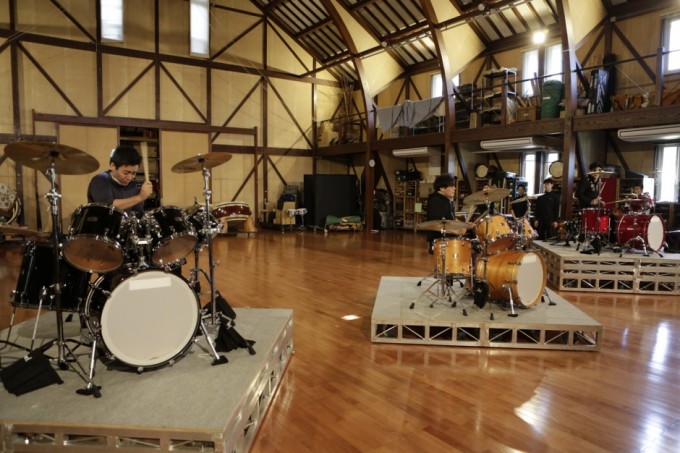
Then, that night after the practice, I noticed for the first time that the air in the rehearsal hall felt the same as when we have been practicing Yatai-bayashi non-stop, which is a traditional Japanese festival taiko piece as well as an iconic Kodo stage piece. It’s also the first thing that all Kodo apprentices learn to play during their training.
After we play Yatai-bayashi non-stop, a faint ringing lingers in our ears and a slight heat and smell of sweat lingers in the air.
When I noticed that sense, I thought: “It’s the same…”
The act of pounding something furiously. Perhaps it is the hunting instinct that lies deep within all human beings. When we face the taiko drum, that overwhelming primal urge to pound it arises from deep inside. It’s not an emotion like anger, it’s an instinct. It’s like a roar within you.
The feeling of your soul stirring and trembling.
At last, I felt that sense, that roar, when I was playing the drums. That roar that emerges when I play taiko.
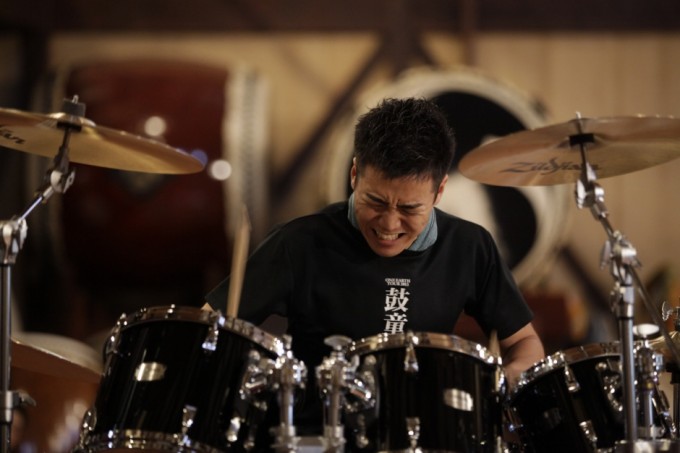
There are different cultures such as Western, Eastern, and Japanese, but this sense goes beyond any of those definitions, or rather, it comes from somewhere deep within all of them.
I am Japanese, I am a taiko player, but this sense is deeper than that. It is part of my identity as a human being.
Well, I’m not really sure which words I should use to express what I’m feeling, but I can say that I felt this sensation intuitively.
So, getting back to the topic, some people see “Chaos” and say, “Why don’t you just play taiko?” Actually, I have always played taiko thinking that it was the right instrument for me.
I think everyone has a set idea about what taiko is, or should be. Not only taiko players, but also our audiences have a set idea about what they expect when they hear the word “taiko.” Taiko is an instrument created by using the trunk of a tree that is centuries old and covering it with animal hides. So it has a lot of life force and history within it. Whether it is on the surface or otherwise, as I said, the person who beats it will feel their soul stir. But I think most people take that for granted and don’t really give it a second thought most of the time.
So for us, beating an instrument for this performance that is not a Japanese taiko drum has led to many new realizations… and questions like these:
If we pound drums with plastic heads… can we convey the same soul stirring roar? Can we move people with our drumming, without the power of our taiko drums?
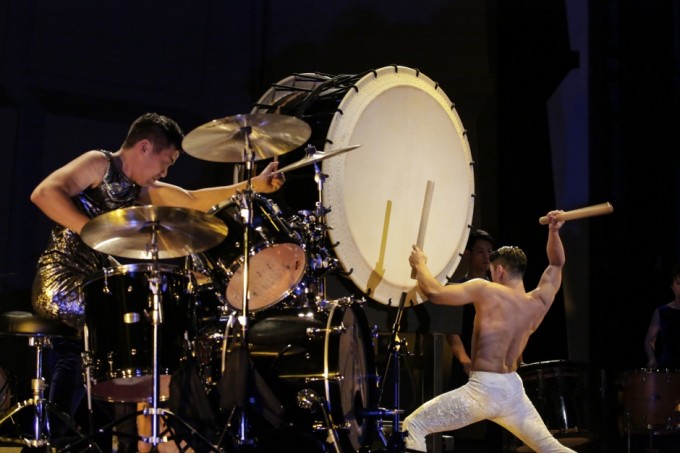
I think it would be great if we could do the same thing a puppeteer does on stage.
You may look at a puppeteer and think: Why do you use a puppet? You are a human, and humans can express many different emotions and move so fluidly. So you could express yourself better without the puppet.
But by expressing yourself through a puppet, something that is lifeless and inorganic, you are pushed to tap into the essence of your expression to make the puppet come to life so you can convey your intentions to the audience.
So I hope we can do the same thing using drums instead of taiko for this performance. By pounding the drums instead of taiko, I hope that we can tap into the soul and “roar” behind our drumming. I hope that it will become even more apparent to our audiences.
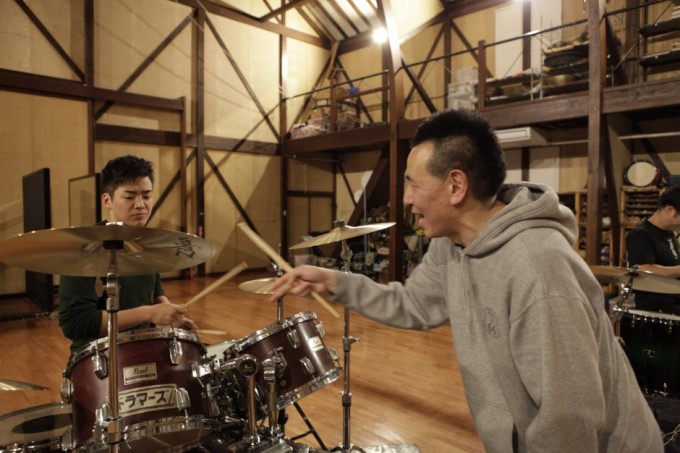
Of course, it’s not all about pummeling the drums like a maniac. By learning to play the drums and practicing hard, I have learned many new things related to music and technique that I would not have felt or discovered if I had continued to only play taiko.
When I perform on stage in “Chaos,” I try to put all these feelings, and everything I have learned through this production, into each performance.
We still have a few performances left on this tour and I really hope you will come along to see this production live on stage. I hope we can stir something deep within our audiences with our drumming, regardless of the instrument.
“Our Sado Performance Tomorrow” by Yuta Sumiyoshi
Performance on Sado Island on May 19th!
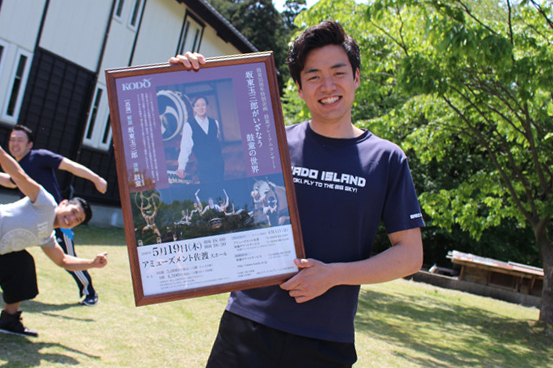
On May 19, we will perform a new piece that I composed, which will feature in “Kodo One Earth Tour: Spiral” from September. This is a special addition to the Sado Premium Concert that will not be included in the other Premium Concerts. So don’t miss it! Please come along!
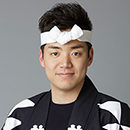
[Kodo 35th Anniversary Special Event] Kodo Premium Concert
–An Invitation from Tamasaburo Bando into the World of Kodo–
May 19 (Thu), 2016 Amusement Sado, Sado Island, Niigata
Doors Open: 18:00 / Start: 18:30
Tickets: SS-seats 5,000 yen, S-seat 4,500 yen *Elementary to high school students receive 2,000 yen back at the door.
Seating Details: All seats reserved. Please refrain from bringing preschoolers (ages 5 & under).
Ticket Outlets: Amusement Sado Tel. 0259-52-2001 (Tue–Fri, 9:00–17:00, tickets must be collected at Amusement Sado), Kodo Ticket Service Tel. 0259-86-2330 (Mon–Fri, 9:30–17:00)
Sado Performance Details: http://www.kodo.or.jp/oet/20160519b_en.html
“Rehearsals for Brand New Production ‘Chaos'” by Yuta Sumiyoshi
Apr. 27, 2015
Rehearsals for Brand New Production “Chaos”
Our rehearsals began with a talk from artistic director Tamasaburo Bando about the new production’s title, “Chaos.”
While the title is “Chaos,” Tamasaburo said he wants the audience to feel “harmony” when they come to this performance. If he called it “Harmony,” noone would know where that harmony would occur. Harmony has somewhere to emerge from somewhere, so you need chaotic parts. As he explained the concept to us, he jokingly admitted that this might be a humble Japanese form of expression.
This production features Japanese drums (wadaiko), naturally, but it also incorporates Western drumkits.
“Another Side of Mystery: Kusa-wake” by Yuta Sumiyoshi
Kusa-wake
I composed this piece for the “Amaterasu” encore performances in 2013.
According to Japanese legend, once upon a time when Amaterasu, the sun goddess, hid away in a cave, the world was plunged into darkness. Greatly troubled by this situation, all the other gods & goddesses came together to discuss what could be done. Kuwa-wake depicts this scene from the famous tale.
To express that conversation between the gods, I focused on incorporating elements such as combinations of rambling changes of rhythm and pianissimo sounds. Kusa-wake differs from other Kodo compositions to date in that it makes the most of hollow sounds as well as hearty sounds. This piece incorporates a wide, dynamic range of volume from really tiny sounds to huge, strong sounds.
There are theatrical elements to our performance of this piece in “Amaterasu,” so when we perform this piece in “Kodo One Earth Tour: Mystery,” we put those theatrical elements into our musical expression instead. However, we are very careful to maintain that feeling of having a conversation with each other while we perform it.
When we perform it on stage, we let ourselves go with the flow as the rhythms push, pull, and repeat. I hope you’ll enjoy the unique vibes and groove created by our “conversation.”
Kodo Discography | Mystery
[Purchase on CD]
Kodo Online Store | Mystery [CD]
[Purchase Download Version]
![]()
![]()
![]()
“Fire-Walking Event at Fukugonji Temple” by Eri Uchida
Dec. 14 Performance at Fire-Walking Event at Fukugonji Temple
We performed at this year’s Fire-Walking Event at Fukugonji Temple in Komaki, Aichi. Unfortunately, there was bad weather on the day of the performance, but the venue was lively from early on in the morning with performances by a variety of groups and stalls selling tasty fare.
This is the second time for Kodo to perform at this event, following on from last year. Before the event started, the temple priests briefed us on the origins of the ritual. I felt so honored to be able to perform at their event, which has been held for centuries. I was determined to do my best.
As evening drew nearer, the temperature went down steadily. A bell was sounded at 5 o’clock and we started our performance right there in the bell tower. They kept ringing the bell during our performance. The sound of our taiko echoed out nicely far and wide– perhaps that is because the tower was built so that the sound of the bell could be heard at every corner of the village?
After that, we performed on the main stage right in front of the spot where the fire-walking ritual took place. It was colder than I had expected… so cold that any of our skin not covered by clothing hurt intensely. Surprisingly, that painful chill actually cheered us on.
For O-daiko, Kenta Nakagome was playing on the front of the big drum and it looked like his back was giving off steam. You could tell from Yuta Sumiyoshi’s drumming on the back and Tetsumi Hanaoka’s chappa (cymbal) playing that they were getting into the spirit of it, too.
We started to play Yatai-bayashi as the fire was set alight. I think our performance sounded a little bit different in front of the firey blaze and smoke.
However, no matter how much heart we put into the performance, it was freezing cold! I did not feel cold during our performances, but I seemed to be shivering so much, and that caused a lot of muscle pain deep inside my body which hit me the next day.
This ritual tells of the horror of all-consuming fire, but at the same time, I learned the horror of the opposite: coldness. The power of nature is beyond our own. This experience made me reflect on the way I spend my time in winter: I realize that if you stay wrapped up too warm in winter, you become a weaker human being!
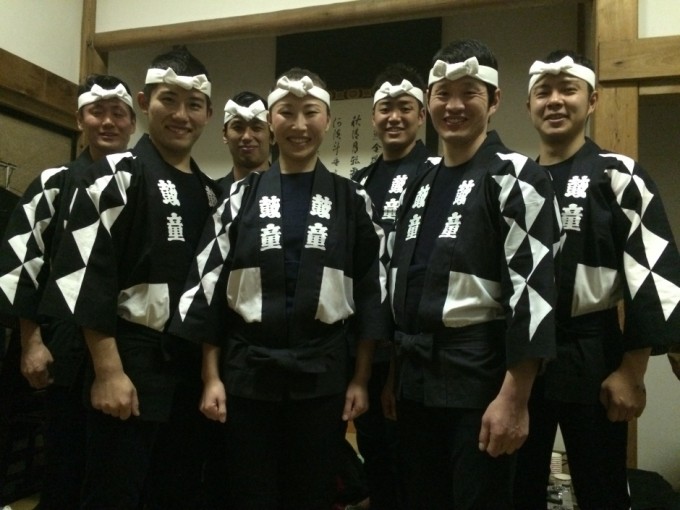
The “School Workshop Performance Tour” members are all doing well!
“What I Focus on When I Create New Pieces” by Yuta Sumiyoshi
Oct. 12, 2014
I am writing this blog post on my day off in Saitama Prefecture. On our days off, we all go about our normal daily lives.
Me? Well, I went for a bit of a run this morning and right now I am at laundromat, watching the tumble-dryer do its thing. Our tours always get so hectic, so times like this to chill and stare off into space are unexpectedly precious. Ideas for new taiko pieces often come to me at times like this.
So, today I would like to talk about what I think is most important when I compose pieces.
When I create a new piece, I always make it thinking about incorporating a moment that will move the audience listening or watching and give them goosebumps. I do not know if “goosebumps” is the best expression, but hope you can kind of get what I mean by that…
I think this sensation of goosebumps, or chills, is something that everyone feels, regardless of their own personal preferences or cultural background.
Such different music, impossible to list, is scattered around the world, and to me good music always has a moment somewhere that gives people goosebumps. I think there are various things that move us in music, like the distinct characteristics of the musical instruments, development throughout the piece leading up to that moment, phrasing, and so on. On the other hand, sometimes I think these moments are related to the certain charms of the performers who bring the music to life.
To create music, I think it is also very important to study musical elements and their cultural background. Then, we can recreate new pieces by filtering those elements through our own sensibilities.
“Kodo One Earth Tour: Mystery” Message from Yuta Sumiyoshi (Japanese)
The fall “Kodo One Earth Tour 2014: Mystery” Japan Tour begins this month. In this video, cast member Yuta Sumiyoshi talks about “Mystery.” (Note: This message is in Japanese)
Watch on You Tube▶http://youtu.be/Cv1EkQP4Zpo
Photos: Takashi Okamoto
“Performance in my Hometown Area, Kagawa” by Yuta Sumiyoshi
I was still a junior member the last time I came to Takamatsu in Kagawa on the “One Earth Tour.” In those early days, I was just frantically playing taiko, clinging tight to every lesson the Kodo members were teaching me. So coming back to Kagawa to perform again, about two years on, made me wonder deep down how much I have grown as a performer since last time.
I had the opportunity to write some of the music for the production we are presenting this time, “Mystery.” I write songs using fragments of pieces I composed when I lived in Kagawa and mixing them with new inspiration that came to me after I moved to Sado Island. Through this production, featuring these pieces, I hope that others can see how much I have grown and how much change I have been able to embody. I also hope people can sense something constant in me, a base within me that doesn’t change.
Before I went to Sado Island (to become a Kodo apprentice), I played taiko every day with my childhood friends, somewhat uncertain about the right way to play. I left my childhood friends, went to Sado Island alone to join Kodo, and now I’m playing taiko professionally.
After the performance in Takamatsu, a teacher, who has watched over me growing up since I was really young, said to me, “No matter how great of a pro taiko player you’ve become, your songs still haven’t changed since you were a junior high school student. Even if the melodies and rhythms are different, your taste remains throughout the composition. It’s nostalgic and I’m happy about that.” To have someone who had worked on polishing my musicianship for over 10 years say those words to me, I was so happy I could cry and at the same time I felt determined to aim even higher and work to become a person that everyone to whom I am indebted would be proud of.
Our performance in Kagawa was a chance for me to feel the warmth of my home region, and to take a new look at my own hopes and intentions.




